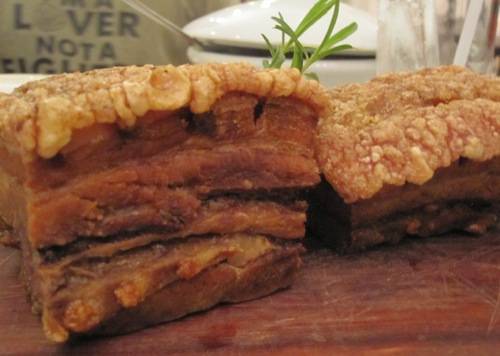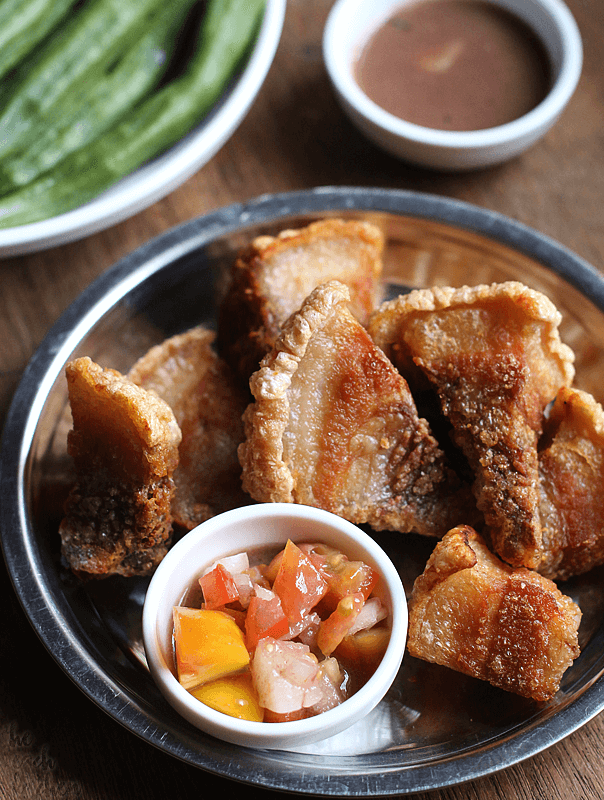BAGNET (Deep Fried Pork Belly)
Bagnet is no doubt the most famous Ilocano dish. When you think of Ilocos Norte, the first thing that will come into your mind would surely be bagnet. It has become Ilocos Norte’s Holy Grail if it comes about Ilocano dishes. Granted that Lechon is the most popular dish in the Philippines, but, bagnet isn’t that far behind.
The most common name for bagnet outside the Ilocos Region is chicharon. But why did it have its own name? It’s because by the way it looks and how it is prepared and cooked. Unlike chicharon, bagnet comes in slabs. The nearest dish that could think of in terms of similarity is Lechon Kawali.

Photo from kusinamasterrecipes.com
Chicharon was introduced to the Filipinos by the Spaniards during their occupation in the country. Though I cannot guarantee any confirmation on how long bagnet has been around and became a contemporary dish, but, by the way it looks, it’s not that far away from the introduction of chicharon in the country. As old as when cooking oil was introduced to the Filipinos, hah!
Not only bagnet can be served as a meal, but it can also be used as a topping to most of the sautéed vegetable dishes in Ilocos Norte (i.e., pinakbet, adobong sitaw, ginisang kalabasa, etc…). Other people would claim that it brings “balance” to their sautéed vegetable (vegetables being healthy and bagnet being unhealthy due to high cholesterol it carries!).
Cooking Bagnet may take time and patience. You can do shortcuts if you’re a little out of time, but that’ll make the dish’s authenticity tampered. Ilocanos are known for being very patient in most situations surrounding them so that they can utilize most of their time and make the very best out of it.
Bagnet is best served with kamatis, bagoong, lasona (tomatoes, fermented anchovies, and spring onions) or also known to the Ilocanos as KBL. That’s the everlasting ties that can’t be broken by any means!

Photo from thepeachkitchen.com
Anyhow, here’s what you need for you to make one:
- 1.5 kilos of pork belly
- 1.5 liter cooking oil
- Salt
- 4 cups of water
- 3 tomatoes, chopped
- A bundle of spring onions, chopped
- 4 tbsp of fermented anchovies
PROCEDURE:
- Clean the pork belly thoroughly. Rub it with your hands with salt. Rinse.
- On a cooking pot, add 4 cups of water, .5 liter of cooking oil, salt, and the pork belly altogether. Fire up the gas stove and let it boil and simmer for 40 minutes to an hour, until the meat is tender.
- By adding cooking oil to the simmering process will make the meat partly fried. An excellent method that Ilocanos uses, making it unique. Once tender, remove the meat from the cooking pot. Let it rest and make it cool and dry.
- Now, if you want your bagnet to be extremely crispy, let it sit out under the sun or over a coal heat for a couple of hours. Note that this is only optional if you have the time, and you should have the extra patience to do this. Double-dipping it is okay, but it will mostly end up darker in color and a bit bitter.
- Next, on a deep cooking pot, pour in 1 liter of cooking oil, let it get up to temperature until it’s hot enough. Once hot enough, slowly put the pork belly. Please do not drop it instantly to avoid the hot oil splashing over you. Also, do not cover the cooking pot. Let it fry for 2-3 minutes or until it gets to your preferred crispiness.
- Now remove the fried pork belly from the cooking pot and drain the oil, let it rest for about 10 minutes.
- While it’s resting, make the dip: combine all the chopped tomatoes and the spring onions with the fermented anchovies.
- Lastly, slice your bagnet into large dice or adobo-cut-sizes.
- Serve and enjoy.
While it is high cholesterol, eat responsibly.
Side Note: Leftover bagnet can still be used as toppings to sautéed vegetables.

Photo from windowseat.ph
